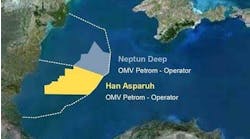Offshore staff
HOUSTON –Total E&P Angola is pursuing a comprehensive strategy to maximize recovery from its block 17 fields offshore Angola, which include its Girassol, Dalia, and Pazflor projects.
The strategy was outlined by Pascal Carrier, vice president–projects, Total E&P Angola, on Monday at theOffshore Technology Conference in Houston. It calls for the enhancement of existing field production through the implementation of enhanced oil recovery techniques, and the development of nearby reserves using existing installations.
To that effect, a coordinated initiative named Projects Brown Field (PBF) has been launched in Luanda to start the brownfield era of this basin, Carrier said. The objective is to ensure maximum focus on reserves by optimizing use of existing facilities and techniques, and creating synergies between all nearby deepwater projects.
Key components of this initiative, Carrier noted, include using one single structure to manage all projects, maximizing modifications, and minimizing shutdowns. Another key part of the strategy is to employ existing equipment where possible, and he cited the example of a multi-phase boosting pump that could enhance recovery in several fields.
He noted that Total will also share personnel between projects in the block, and work with other greenfield projects in the area, such as Pazflor and CLOV, in order to enhance efficiencies and lower costs.
Officials with the new PBF organization will interface between these various projects, and Carrier said that 60% of the personnel on its block 17 projects work on at least two of these projects. He also noted that managing the various phases of these projects would be a key challenge.
Other challenges will include development of local content, local fabrication of equipment, and development of local engineering expertise. But efforts to develop and promote these aspects were under way, Carrier commented. He also noted that some of its block 17 projects are employing 100% local content. Another key challenge, he said, will be to integrate new technologies within existing facilities and implementing modifications within existing topsides areas.
Carrier was joined onstage by Jean-Luc Le Rodallec, PBF field operations manager of Total E&P Angola. He said that one such brownfield project in block 17, the Girri Rosa MPP (multi-phase pump) project, will make use of the Girrasol and Dalia FPSOs. Le Rodallec added that two multi-phase pumps will be employed on this project, with the addition of gas lift to enhance recovery.
Other brownfield projects being developed by Total in block 17 include the Dalia de-bottleneck project, which will involve produced water treatment, the addition of a heat exchanger, and “a lot of work on the FPSO,” Le Rodallec said.
Other such projects include the Dalia 1A project, which will make use of water injection and an upgrade of the integrated control and safety system; and the Zinia Phase 2 project, which will make use of the Pazflor FPSO, and involve topsides integration and subsea network modifications.
Total first discovered hydrocarbons in the block 17 basin in 1996, and developments in the area have included Dalia, brought online in 2006, as well as Rosa (2007), Girri (2009), and Pazflor (2011). All of these employed FPSOs for field development and production. The CLOV project, also in block 17, will also make use of an FPSO. It is expected to be brought online this year.
5/07/2014


